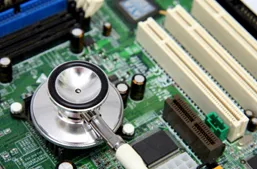
Open an electronic healthcare record and click on a field. What happens? Underneath the covers of your EHR application, a lot is going on. Software vendors often tout the fact that they use a single database to store all the relevant information in a healthcare record.
You’re a CIO. You know better.
The reality is that much of the information that resides in the EHR database came from somewhere else and may be headed to a distant location. When a doctor reads Mr. Smith’s record, she may look at recent test results, reference reports from other doctors, show the patient an X-ray, schedule a follow-up visit with a specialist and check that all-important health insurance information. All of this data may have originated in different facilities and some components, like the X-ray, may be stored remotely. When the doctor submits a patient claim, electronic forms may travel thousands of miles, several times. Each click on a patient record may result in many hops across multiple systems and networks.
In this interconnected IT environment, data is pulled from many different sources. A slowdown in your EHR application can therefore occur at any one of these touch points. Perhaps the connection to a networked hospital is experiencing slow response times and your EHR cannot pull up a patient’s medical history, for example. Or, maybe your invoice generation process is broken and cannot connect with insurance companies to ensure prompt payment for tests and procedures.
There are three unforgivable sins in EHR systems: missing functionality, slow performance and missing data. If the system is unavailable, sluggish, or lacks key features your clinical staff will find ever more creative ways to work around it. Additionally, if a third party system is down your staff cannot see the information they need to effectively carry out business processes or patient care.
Your success lies in deploying the required features and ensuring that information flows smoothly across all interconnected systems. The challenge, of course, is that some of these systems may be under your direct control and some may reside elsewhere – at another company or in the cloud. Healthcare organizations must therefore have a strategy in place for monitoring EHR performance and knowing what to do if an EHR application starts to slow down.
Trouble signs include slow response times, stalled business procedures, staff who work around the EHR system and inflexibility. If your EHR is experiencing inconsistent performance, patient care and revenue cycle management processes will suffer. In addition, physicians may revert to paper systems which can easily cause information to become lost or outdated. Finally, without visibility into your IT environment, your hospital will be unprepared for an unexpected event such as an outage.
Recently I worked with a deployment of a healthcare administration application to understand how the different dependencies affected performance. This deployment was a very typical example in which a full understanding of the application is critical in order to ensure fast and reliable delivery. Here, batch processes and user requests were all working on the same data. This was challenging because the performance impact of these transactions could not be fully tested in non-production due to their constantly evolving datasets.
Luckily there is a new generation of software tools to address these issues. In particular, commercially available Application Performance Management (or APM) software can help both providers and payers ensure that all of their interconnected systems work in concert to deliver patient care and get paid for doing so.
APM software supports many applications, on different operating systems, databases, programming languages, technologies and networks. It is now possible to track all steps in every transaction regardless of complexity. From a clinical perspective, this means that your organization can understand and manage the performance of your applications instantly, however heterogeneous, no matter how interconnected, wherever they reside. From a business perspective, it means that your EHR, HIS and other clinical applications will work more smoothly, and when a problem does occur, all relevant information will be at hand as you search for a solution.
With APM, you can proactively detect and fix performance problems to ensure your staff are satisfied with and use your EHR system rather than working around it. Comprehensive APM solutions also offer visibility into the many different interactions within your IT environment and pinpoint the problem area, whether it is a slow connection to a networked hospital, a stalling EHR entry or some other delay. This allows you to ensure consistent response times when pulling data from your EHR and gives you the ability to rapidly resolve problems in the event of a slowdown or an outage.
Your world is becoming more and more complex. Focus on performance and functionality to ensure that your healthcare systems are part of the solution and not the problem.


